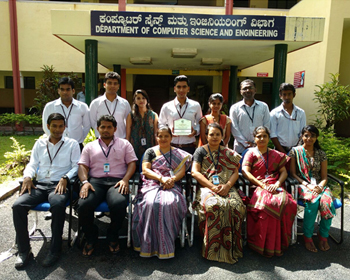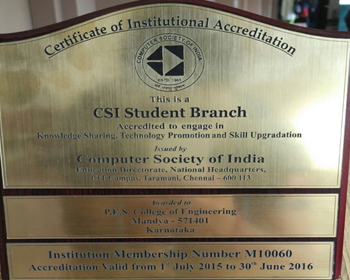Program Overview
The Department of Computer Science and Engineering (Data Science) was established in the year 2023. The department is dedicated in shaping Engineers who are equipped not only with technical knowledge, but also with creativity, ethics, and problem-solving abilities.
The curriculum of the department is crafted by team of experts covering the core concepts of Computer Science along with focused courses on Data Science to align with industry expectations and to equip students with the skills needed to harness the power of data and drive innovation.
Students are encouraged to participate in Hackathons, Technical events, Extracurricular/Co-curricular activities to promote practical learning and innovation.
With a supportive academic environment, expert faculty and strong Industry connections, the department prepares students to lead a successful career in IT Industries or pursue Higher Education and Research or evolve as Entrepreneurs.
Total Intake(CS&E department)
240
Total Intake(CS&E (AI & ML))
60
Total Intake(CS&E (Data Science))
60
Total Intake(Computer Science & Business Systems )
60
Program Type
UG
Duration
4 Years
- About Course
- NBA
- Academic Calender
- Faculty
- Placement
- Research
- Professional clubs and chapter
- Achievements
- Activities
- Results & Role of Honor
- MOOCs
Academic programs offered
UG Program
- Bachelor of Engineering (B.E.) in Computer Science and Engineering (Data Science) with approved intake of 60 students.
Vision
The Department of Computer Science and Engineering (Data Science) aspires to create globally competent, ethically strong and socially responsible data science professionals capable of driving innovation and addressing societal challenges.
Mission
- DM1: Implement best practices in teaching and learning through dedicated faculty and supportive infrastructure to effectively impart knowledge to excel in the data-driven world and contribute meaningfully to society.
- DM2: To offer training programs that bridges the gap between academia and industry through industry collaboration.
- DM3: Grooming professionals with high ethical values and ability to solve real-life problems.
- DM4: To provide students with an academic environment that makes them aware of excellence and lifelong learning in emerging technologies.
Program Educational Objectives (PEOs)
Graduates of the program will be able to
- Have Successful computer professional career in IT industry and related areas
- Pursue higher education in engineering or management with the focus on intensive research and developmental activities.
- Develop their career as entrepreneurs in a Responsible,Professional and ethical manner to serve the society
Program Outcomes (POs)
Engineering Graduates will be able to
- PO1: Engineering Knowledge: Apply knowledge of mathematics, natural science, computing, engineering fundamentals and an engineering specialization as specified in WK1 to WK4 respectively to develop to the solution of complex engineering problems.
- PO2: Problem Analysis:Identify, formulate, review research literature and analyze complex engineering problems reaching substantiated conclusions with consideration for sustainable development. (WK1 to WK4)
- PO3: Design/Development of Solutions:Design creative solutions for complex engineering problems and design/develop systems/components/processes to meet identified needs with consideration for the public health and safety, whole-life cost, net zero carbon, culture, society and environment as required. (WK5)
- PO4: Conduct Investigations of Complex Problems:Conduct investigations of complex engineering problems using research-based knowledge including design of experiments, modelling, analysis & interpretation of data to provide valid conclusions. (WK8).
- PO5: Engineering Tool Usage:Create, select and apply appropriate techniques, resources and modern engineering & IT tools, including prediction and modelling recognizing their limitations to solve complex engineering problems. (WK2 and WK6)
- PO6: The Engineer and The World:Analyze and evaluate societal and environmental aspects while solving complex engineering problems for its impact on sustainability with reference to economy, health, safety, legal framework, culture and environment. (WK1, WK5, and WK7).
- PO7: Ethics:Apply ethical principles and commit to professional ethics, human values, diversity and inclusion; adhere to national & international laws. (WK9)
- PO8: Individual and Collaborative Team work:Function effectively as an individual, and as a member or leader in diverse/multi-disciplinary teams.
- PO9: Communication:Communicate effectively and inclusively within the engineering community and society at large, such as being able to comprehend and write effective reports and design documentation, make effective presentations considering cultural, language, and learning differences.
- PO10: Project Management and Finance:Apply knowledge and understanding of engineering management principles and economic decision-making and apply these to one’s own work, as a member and leader in a team, and to manage projects and in multidisciplinary environments.
- PO11: Life-Long Learning:Recognize the need for, and have the preparation and ability for i) independent and life-long learning ii) adaptability to new and emerging technologies and iii) critical thinking in the broadest context of technological change. (WK8)
Program Specific Outcomes (PSOs)
The Under Graduate (UG) of B.E Computer Science & Engineering(Data science) Program has defined Program Specific Outcomes (PSO) which are listed below.
- PSO1:Ability to apply core concepts of Computer Science, Mathematics and Data Science to design and develop scalable solutions for Engineering problems.
- PSO2:Ability to apply Analytical skills to formulate effective and sustainable solutions in various domains.
| Program Name | Duration | Start | End |
|---|---|---|---|
| CSE(DS) | 4 year | NA | NA |
2021 - 2022 Academic Year
2020 - 2021 Academic Year
| Faculty Name | Designation | Email-Id |
|---|---|---|
| Dr. Anitha M L | Professor and Head of Department | anthaml@pesce.ac.in |
| Name | Guide Name | University/Research Center | Topic Status |
|---|---|---|---|
| R.S.Prasanna kumar | Dr S N Thimmaraju | VTU | Course work Completed |
| Veena M. | Dr. M.C. Padma | VTU | Comprehensive Viva Completed |
| Girish Babu | Dr. M.C. Padma | VTU | Comprehensive Viva Completed |
| Suraj B S | Dr. M.C. Padma | VTU | Registered and preparing for course work |
| Ramyashree H P | Dr. Minavathi | VTU | Comprehensive Viva Completed |
| Deepika | Dr. Nagarathna | VTU | course work Completed |
| Shwetha M K | Dr. Nagarathna | VTU | Registered and preparing for course work |
| Chaitra B P | Dr. M L Anitha | VTU | Registered and preparing for course work |
| V Chethan kumar | Dr. Umesh D R | VTU | Registered and preparing for course work |
| Shruthi P S | Dr. Umesh D R | VTU | Registered and preparing for course work |
| C Chethana | Dr. Deepu singh | VTU | Registered and preparing for course work |
| Bhavya D | Dr D S Vinod | JSS,Mysore | course work completed |
| Jayshankar | IIT,varanasi | course work completed | |
| Yoga B S | IIT,Roorkie | Registered |
| Research Scholar | University | Guide Name | Title of the Research | Status |
|---|---|---|---|---|
| Dhananjaya Kumar K | Visvesvaraya Technological University | Dr. Anitha M L | Intelligent Predictive Model For Traffic Congestion And Monitoring System | Course work completed |
| Anitha T Nair | Visvesvaraya Technological University | Dr. Anitha M L | Segmentation Assisted Classification of Diabetic Retinopathy using Deep Learning Models | Open Seminar 1 and 2 Completed |
| Pankaj Kumar G | Visvesvaraya Technological University | Dr. Anitha M L | AI-Driven Strategies for Optimal Move Prediction in Board Games | CV Completed |
| Application Number | Title | Faculty | Status |
|---|---|---|---|
| No. 201741020992 | AI based Inventory Management system & method thereof | Dr. R Girisha | Published |
| No. 201741020994 | Electronic processing of paper invoices | Dr. R Girisha | Published |
| No. 201741020993 | System & method for automatic data management between user devices | Dr. R Girisha | Published |
| No. 201741020991 | A Method & system for Business Intelligence Analytic | Dr. R Girisha | Published |
| No. 201741020994 | Electronic processing of paper invoices | Dr. R Girisha | Published |
| No. 201741021216 | A system & method for buying & selling goods | Dr. R Girisha | Published |
| Project Title | Year | Funding Agency | Amount (Rs.) | Status |
|---|---|---|---|---|
| Establishing the Internet of Things (IoT) Laboratory for Post Graduate and Research programs | June 2016 | VGST | 20 Lakhs | Sanctioned |
| Business Incubator- Support for Entrepreneurial and Managerial Development of SMEs through Incubators | January 2017 | MSME, Govt. of India | 6.25 lakhs for each project | Sanctioned |
| Setting up Network Forensic lab under VGST | August 2017 | VGST | 20 Lakhs | Sanctioned |
Professional Bodies
ISTE PESCE CHAPTER
Indian Society for Technical Education is a professional organization of engineering educators and educational administrators. It is a society registered under the societies Registration Act XXI of 1860. The principle objective of ISTE is to advance the cause of education in general and all its functions which pertain to engineering and also to serve as common agency for simulating and guiding its members to formulate strategies for development of technical education and research.
ISTE had been engaged in a variety of programmes and actions leading to the upgradation and modernization of present day curriculum, faculty and educational infrastructure so as to make the technical education in India comparable with that in the advanced countries.
PES College of Engineering, Mandya became Institutional Member of ISTE in the year 1986.
ISTE-PESCE Chapter, which is a branch of Indian Society for Technical Education, New Delhi, took birth in the PES College of Engineering campus in the year 1989. Almost all the staff members of the institution are life members of ISTE. The members are benefited through attending short term courses and other activities of the ISTE.
Since the beginning of the chapter, many activities have been conducted in the institution for the benefit of staff members and students. A few Programs was also conducted for the family members like short tour, get together, games to spouses and children etc.,
Related Links
ISTE PESCE facebook link ISTE PESCE Instagram linkIEEE PESCE
What started as an elite group 13 years ago, today has sprawled throughout the campus of PESCE making the students technically more competitive, more professional and enhancing their abilities as an engineer. Since then IEEE-PESCE student branch, a division under region 10 of IEEE has been known for the immensity with which its members were bestowed. The very success story of its students as professionals in their respective fields after graduation speaks of its standards. IEEE-PESCE is a blooming group of more than 100 active members involved in participating and organizing a range of activities aimed at enhancing their academic, professional and career lives, with the thoughtful support and guidance of mentors.
IEEE-PESCE Student Branch at PES College Of Engineering, mandya, Karnataka, empowered to grow technically, professionally and academically to grid oneself to be technically proficient with the ebullient attitude that engenders to build a wonderful career ahead. We consider ourselves to be lucky enough to be a part of this growing family and find overwhelmed to welcome everybody to this home of people striving to be savant.
This Student Branch of IEEE, budding since 2007 to create an ambiance where each can flourish by displaying their skills and be abreast with the latest developments in cutting edge technology through team meets and various other events like seminars, workshops held regularly. The most unique Social Activity wing works for something more than just an act of favour charity directed towards doing something for the society. For the efforts that we put in, we have been recognized by the IEEE Bangalore Section and awarded various awards few amongst which are the Best Branch Counsellor Award, Best Website Award and Best Student Volunteer Award, Outstanding Student Volunteer.
Awards won by IEEE-PESCE Student Branch
| Award | Year | Awarded to |
|---|---|---|
| IEEE Mysore Subsection Outstanding Student Volunteer Award | 2023 | Aniruddh P Koundinya |
| IEEE Mysore Subsection Most Promising Student Branch Award | 2021 | PESCE, Student Branch |
| IEEE Mysore Subsection Outstanding Student Volunteer | 2021 | Yeshwant L M |
| IEEE Mysore Subsection Outstanding Student Volunteer | 2021 | Skanda M K |
Projects under IEEE Funding
| Project Name | Developed By | Funded Body |
|---|---|---|
| Virobot: The artificial nurse project | Manikanth Amaresh and Savadatti | IEEE India Council |
| Virobot Mini Prototype | Team Leader: Manikanth Amaresh and Savadatti Team Members: Sushma H S, Dhanush J, and Preetham kishore |
IEEE Student Humanitarian Project |
| Internet Multi Bot | Team Leader: Manikanth Amaresh and Savadatti Team Members: Anup P H, Sushmitha H S, & Bhoomika H J |
IEEE Student Innovative Project |
Contact Us
| Name | Position | Contact Number | |
|---|---|---|---|
| Dr. Vinay S | Branch Mentor | vinay@pesce.ac.in | +91 9986515835 |
| Dr. Punith Kumar MB | Branch Counsellor | punithpes@gmail.com | +91 98444 82308 |
| Dr. Padma MC | WIE Society Mentor | padmamc@pesce.ac.in | +91 9141113030 |
| Dr. Anitha ML | COMSOC Mentor | anithaml@pesce.ac.in | +91 9945576186 |
| Pavan Kumar K | Student Chairperson | pavankumar8656@gmail.com | +917603858545 |
Related Links
SAE COLLEGIATE CLUB-PESCE
SAEINDIA is India's leading resource for mobility technology. As an individual member driven society of mobility practitioners the ownership of SAEINDIA wrests with its members who are Individuals from the mobility community, which includes Engineers Executives from Industry, Government Officials, Academics and Students
SAEINDIA is an affiliate society of SAE International registered in India as an Indian nonprofit engineering and scientific society dedicated to the advancement of mobility industry in India.
SAE Collegiate Club, a student club has been formed in the year 2007 in association with Dept of Mechanical, Automobile, Industrial Production and Engineering. Our club is affiliated to SAE INDIA organization in its Bangalore section. There are about 56898 student members in 468 engineering college throughout India. Our college club is one among them.
By becoming a member of SAEINDIA college club, students become a part of a global organization whose benefits are geared specifically to the needs of the mobility engineering community. Students' formal education and professional development will be enhanced through your SAEINDIA member benefits.
Presently there are 43 student members in our club. The members have organized various technical events such as PAPER PRESENTATION, EXHIBITION Competitions and Technical talks on diverse topics. Our students have participated in the BAJA Competition which will be held every year.
"VIDHWEGH REnergised", "VIDHWEGH ELECTRIFIED", teams comprising of 15 members each, from our collegiate club is participating in a Hybrid event named "ELECTRIFYING GREEN ASPIRATION (EGA)", conducted by SAEINDIA-Bangalore section, which will be held in Bangalore, in the month of November-2017.
Students of our collegiate club are also looking forward to take part in SUPRA-2018 and other events conducted by SAE.
Contact Us
| Sl. No. | Name | Designation | Contact Number | |
|---|---|---|---|---|
| 1 | Dr. J. Venkatesh,HOD, Dept. of Automobile Engg. | Senior Faculty Advisor | 9448648108 | Jvenkateshpesce@gmail.com |
| 2 | B Dinesh Prabhu,Asso. Professor, Dept. of Automobile Engg. | Faculty Advisor | 9480477812 | Bdineshprabhu@yahoo.co.in |
| 3 | Swaroop D G | Student coordinator | 8861027644 | dgswaroop@gmail.com |
| 4 | Thejas M | Student coordinator | 9611661541 | thejasm006@gmail.com |
About CSI
The seed for the Computer Society India (CSI) was first shown in the year 1965 with a handful of IT enthusiasts who were a computer user group and felt the need to organize their activities. They also wanted to share their knowledge and exchange ideas on a fast emerging sector. Today the CSI takes pride in being the largest and most professionally managed association of and for IT professionals in INDIA. The purpose of the society is scientific and education, directed towards the advancement of the theory and practice of computer science and IT. The organization has grown to an enviable size of 100,000 strong members consisting of professionals with varied backgrounds including software developers, Scientists, Academicians, project managers, CIO's, CTO's and IT vendors to just name a few. It has spread its branches all over the country. Currently having more than 500 student branches and rooted firmly at 73 different locations, CSI has plans of opening many more chapters and activity centers in smaller towns and cities of the country. The idea is to spread the knowledge and provide opportunities to as many interested as possible.
THE CSI VISION: "IT for Masses"
Keeping in mind the interest of the IT professionals and computer users CSI works towards making the profession an area of choice among all sections of the society. The promotion of Information Technology as a profession is the top priority of CSI today. To fulfill this objective, the CSI regularly organizes conferences, conventions, lectures, projects, awards. And at the same time it also ensures that regular training and skill updating are organized for the IT professionals. Education Directorate, a special wing of CSI helps physically challenged citizens by providing training 'Punarjani'. CSI also works towards a global approach, by seeking out alliances with organizations overseas that may be willing to come forward and participate in such activities. CSI also helps governments in formulating IT strategy and planning.
CSI- Student chapter, PESCE
To be a part of the distinguished fraternity of famous IT industry leaders, brilliant scientists and dedicated academicians our college has attained institution membership of CSI from 1st January 2015 and it is our privilege to announce that our department has open CSI-student chapter under the leadership of our HOD Dr. M. C. Padma. With her esteem support, around 108 students have registered to become CSI members. The aim of this body is to create opportunity for students to interact with industry professionals and to organize seminars/workshops/competitions etc. The department has nominated Mrs B S Mamatha as student branch co-coordinator for CSI-student chapter and Mrs B P Chaitra & Mr. Yoga B S as nominee members. CSI core committee members are also nominated for our CSI-student chapter and the list is given below.
CSI-Student chapter core committee members
| Name | Position |
|---|---|
| Ruksar Ahmadi | Student Chair |
| Pratyush Kumar | Vice Chair |
| Rubal Guptha | Secretary |
| Ashwini M J | Joint Secretary |
| Abhisht Aharma | Treasurer |
| Vidyashree H K | SAC Co-ordinator |
| Archana Muralidharan | Communication Lead |
| Yashwini S | Designer |
| Shreeraksha | Asst. Designer |
| Kshitiz Raj | Web Master |
| Vishal Soni | Asst. Web Master |
| Albert Abraham | Director of Technical Activities |
| Vidya | Director of Social Activities |
| Vyjayanthi | Membership Head |
Activities
"IGNITING THE INTELLECTS"


INAUGURATION
Objective:Inauguration of Computer Society of India (CSI) student chapter in P.E.S. College of Engineering, Mandya.
Date: 20th November, 2015
Time: 10.00 AM
P.E.S College of Engineering in association with Department of Computer Science and Engineering inaugurated the Computer Society of India student chapter on 20th November, 2016. The CSI chapter of the college consist of more than 75 students including core team members. The Inauguration started with a melodious invocation song which was followed by a welcome speech by the student chair Rukshar Ahmadi who welcomed our privileged guests and addressed the gathering. Our respected principal, Dr. V. Sridhar was the chief guest to this function. Dr.Rajkumar Vedam Consultant Engineer, Houston, Texas, US inaugurated the CSI student chapter by lighting the lamp, in presence of professor and head of department of CSE, Dr M.C. Padma, Smt. Mamatha B.S SBC, CSI-Student chapter, and all the professor of department of computer science
The event proceeded with the address speech of our beloved HOD who enlightened the students on the future goals of the chapter and shared her vision with the student. The event was more successful after the technical talk on Listening, Communication and, Career Opportunities was delivered by Mrs. Vathsala S Bhat, Dean at RIIT Mysuru. The inauguration went ahead with a short quiz event followed by vote of thanks. The overall feedback was quite positive and we hope to conduct more number of events in the upcoming days.
GNU/LINUX USER'S GROUP P.E.S. COLLEGE OF ENGINEERING, MANDYA


GNU/LINUX Users have formed a group called GLUG in P.E.S. College of Engineering, Mandya. The main objective of this group is to provide awareness of free software in students. Free software means software that respects user's freedom and community. Roughly, it means that the users have the freedom to run, copy, distribute, study, change and improve the software. Thus, "free software" is a matter of liberty, not price. To understand the concept, you should think of "free" as in "free speech", not as in "free beer". GLUG campaign for these freedoms because everyone deserves them. With these freedoms, the users (both individually and collectively) control the program and what it does for them. When users don't control the program, we call it a "non-free" or "proprietary" program. The non-free program controls the users, and the developer controls the program. This makes the program an instrument of unjust power. This group is strongly supported by Free Software Movement of Karnataka (FSMK) group.
GLUG, PESCE is active in conducting technical events like regular workshops, Hands-on sessions, conferences, etc. GLUG is co-ordinated by Dr. Minavathi, Professor, PESCE, Mandya.
Table below gives a brief report of GLUG, PESCE activities from 2015 to 2019:
| DATE | ACTIVITY | RESOURCE PERSON |
|---|---|---|
| 17-08-2015 | Orientation | Mr. Rakesh. P, alumni of PESCE, database administrator in SPAN INFOTECH , Executive member, FSMK Organization , Bangalore |
| 29-08-2015 | OSM Tracking Using Android App | Rakesh. P and Shijil Executive members FSMK Organization , Bangalore |
| 29-08-2015 | Session on PHP | Mr. Manu, VTIGER, Bengaluru and Alumni PESCE, Mandya |
| 12-09-2015 | Xubuntu, LINUX Installation Fest | Rakesh, Manu, Vishal and Shijil from FSMK |
| 03-10-2015 | Introduction to basic commands in Linux | Ramyashree P.M and Vaibhav Vishal volunteers of GLUG, PESCE |
| 17 & 18th Oct, 2015 | "DRUPAL" Workshop | Rameez Thonnakkal, joint secretary,FSMK Organization and Shijil Executive member FSMK Organization , Bangalore |
| 19-10-2016 | Introduction to Linux | Shubodip Ghosh and AmoghaVarsha, GLUG core member, PESCE, Mandya |
| 06-11-2016 | Java Chat application | Nootan, GLUG core member, PESCE, Mandya |
| 03-02-2017 | Linux Installation Fest | Praveen Kumar B. N. and Amoghavarsha, GLUG core members |
| 09-02-2017 | Introduction to OSS and Free Software | Anup Pravin, alumni of PESCE and an FSMK member |
| 16-02-2017 | Basic Commands in Linux | Harshitha. R, Anant Mohan and Sindhu, GLUG core members and FSMK members |
| 01-03-2017 | Shell Scripting | Amoghavarsha, GLUG core member, PESCE, Mandya |
| 16-03-2017 | Shell Scripting | Amoghavarsha, GLUG core member, PESCE, Mandya |
| 20th to 24th January, 2019 | Residential Camp – “FSMK Winter Camp’ 19” | Dr. Richard Stallman, GLUG & FSMK core members |
PLUG-IN
It’s not for you, it’s you
Origin
Plug-In is the club which started to help the ECE department students in all the aspects to achieve the proficiency. It was the idea of Adarsh H R, Ganesh R Bhat, Ullas Gowda G L and Nandish Urs N (2013 batch students). It is the only club that has got intiated after 20 long years of closing the great HAMMING club of our department. It is the only club that our department has still today and operated by students only. It has been around one and half year of its establishment in which it has organized many events and few intra college events too from our supporting team. Today we have around 170 students who are there in our club and we are guided by our faculty advisor Mahesh Koti, Associate Professor of ECE department.
What is Plug-In????
Plug-In is a technical group which operates on behalf of ECE Association. Plug-In conducts both technical and non technical events. Through the activities which we conduct we are trying to enhance the skills of the individuals and making them to understand their potential, their talents in handling the situation and finding the best way to stand as a winner.
Moto of Plug-IN
The moto of PLUG IN is,
- To have a honest approach to explore the domain….!
- To provide the platform for the students to carve the best version…..!
- To create a tour to the mysterious world of technology…..!
- Last but not the least, to motivate the students to develop self confidence, discipline and leadership qualities which will help them to build their professional life……
Activities conducted by Plug-In
| Event Name | Year | Description |
|---|---|---|
| Quiz-In | 2015-16 | This was the first activity conducted by Plug-In. The topics were mainly on basic electronics. |
| Talk-In | 2015-16 | This was a technical talk by Dr K A Radhakrishna Rao on Digital Image Processing. It was an industrial interaction with the students. |
| Quest-In | 2016-17 | It was a treasure hunt event and was the most successful event organized by Plug-In wherein 200 students participated in the event. |
| Fumour | 2016-17 | This was organized mainly to see the creativity and thinking ability of the students. |
| Code-Kshetra | 2016-17 | It was a programming event where all the IT department students were allowed to participate, and it was organized twice. |
| Adzap | 2017-18 | It was organized to check the managerial and thinking skills of the students. |
| MATLAB | 2017-18 | This was a workshop organized for the students of the ECE department. |
Even Plug-In organized social activitiy. We thought about operating Computer to the government students who were not aware of that and our beloved HOD Dr K A Radhakrishna Rao sir also donated a Computer to the school.
Plug-In Core team
| Posts | Name |
|---|---|
| President | Vinutha Singh S |
| Vice President | Anupama K M |
| Secretary | Spandana H N |
| Joint Secretary | Meghana M R |
| Treasurer | Kuthejatul Kubra |
| Editor | Anushree Pai G |
| Director of Networking | Pratheek P |
| Director of Technical activities | Disha J H |
| Director of Communication | Faisal Mahmood |
| Webmaster | Harshitha G |
| Director of Membership | Abhilakhi N |
| Pooja J P | |
| Director of Social activities | Ravi Kiran K B |
Hack Club
Hack Club PESCE, Mandya
A group of students with passion to learn and develop. A technical club "By the students-For the students". We learn by making and we enjoy making different fun and awesome projects. The point is to learn and develop technical skills while making friends and enjoying the journey. We want to create a community where we can all discuss and work on skills like IoT, Web Dev, AI, Machine Learning, Robotics, Photography and more (There are other secret sects like Anime, Piracy, etc). This is a completely open community where you don't have to pay any money to join but you have to show us your interest and passion for making. Come join us and make something cool !!!!
Academic Year 2024-25
Student Achievement
| Name | Description of the Achievement |
|---|---|
| Shivam Verma, Alok Singh | Won the title of Best Social Impact at Colossus 2.0, Conducted By Dr. Amedakar Institute of Technology, Bengaluru. |
| Sudhindra Shenoy, Mohammad Ayan, Spandana N, Yashaswini | Won 1st prize in Speak to Inspire conducted by Department of CS&E (Data Science), PESCE, Mandya |
| Spandana N | Won 3rd place, VTU inter collegiate Mysuru division Women's Throw ball. |
| Kushi J Ramu, Spandana Raj, Pallavi N | Runner-up, VTU inter collegiate Mysuru division Women's Volleyball. |
| Nehashre N | Par Naidu Endowment Fund Scholarships for the Year 2024-25 |
| Dhruv S Ram | Won 2nd place, 1500 meter running, inter department competition |
| Dhruv S Ram | Won 1st place in inter department dance competition, Jnana Cauvery organized by PESCE, Mandya |
| Hema Hemmige H S, Spandana N, Priya H S, Spandan Raj, Amulya, Dhruv S Ram | Won 1st place in Inter College Dance competition @ GMIT, K M Doddi, Mandya |
| Spandana N | Participated in Yuva Sambrama @ Dussera Festival, Mysuru |
| Harsha V | Won 4th place in Pitchdeck organized by Eureka-PESCE, E-cell, Mandya |
| Sanjana S | Participated in The Great Bengaluru Hackathon |
| Sanjana S | Took part in Hack Bengaluru |
| Sanjana S | Participated in a Hackathon conducted by Malnad College of Engineering, Hassan |
| Harsha V | Participated in Innovista - 2025, PESCE, Mandya |
| Harsha V | Participated in Design and Innovation Clinic 2025, CMTI, Bangalore |
| Thanusha C | Participated in Robo Soccer, IIT Madras |
| Arbaz Khan | Participated in Robo Soccer, IIT Madras |









